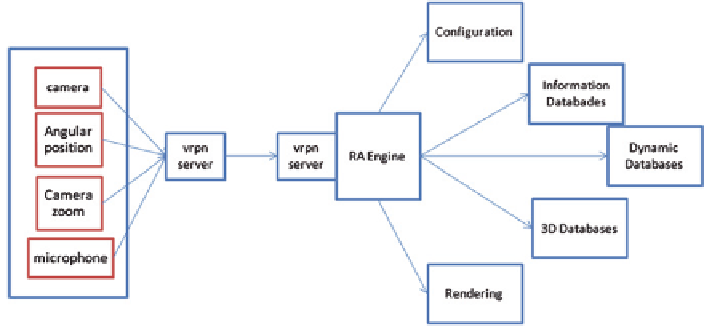Geoscience Reference
In-Depth Information
Fig. 5
Diagram of the augmented reality application
angles are measured by an absolute coder, and the camera has a variable field
of view. The vision is ensured by a micro display device. Focus-command and
selective interface are provided by toothed wheel Fig. (
5
).
We also wanted the telescope to be as modular as possible. So we introduced an
abstraction layer:
VRPN
7
(Virtual Reality Peripheral Network) server.
VRPN
is a
free library which allows for a transparent interface between an application (on a
computer) and a hardware device (linked to another computer on the network).
This library relies on a client-server architecture: the server unit consists of a com-
puter which collects data from the coders and the camera, and the client unit con-
sists of computer whose task is to compute the application.
This type of library has numerous advantages:
• Network abstraction;
• Execution speed;
• Code portability;
• Compatibility with many virtual reality softwares (included
Virtools
);
• Independent Tracking;
• Asynchronous Non-blocking communications.
The augmented reality engine is based upon an open-source library such as
OpenScenegraph
for 3D rendering,
ARToolkit
8
for virtual objet insertion; it is con-
nected to a 3D database (produced by the partners of the project
TerraNumerica)
which contains 3D models of
Paris
buildings. There are other available peripheral
databases providing static information (for example historical) or dynamic (for
example weather forecasts or observations). The Fig.
5
includes a global schema
about our Telescope software layers.
7
VRPN:
http://www.cs.unc.edu/Research/vrpn/
.
8
ARToolkit:
http://www.hitl.washington.edu/artoolkit/
.

